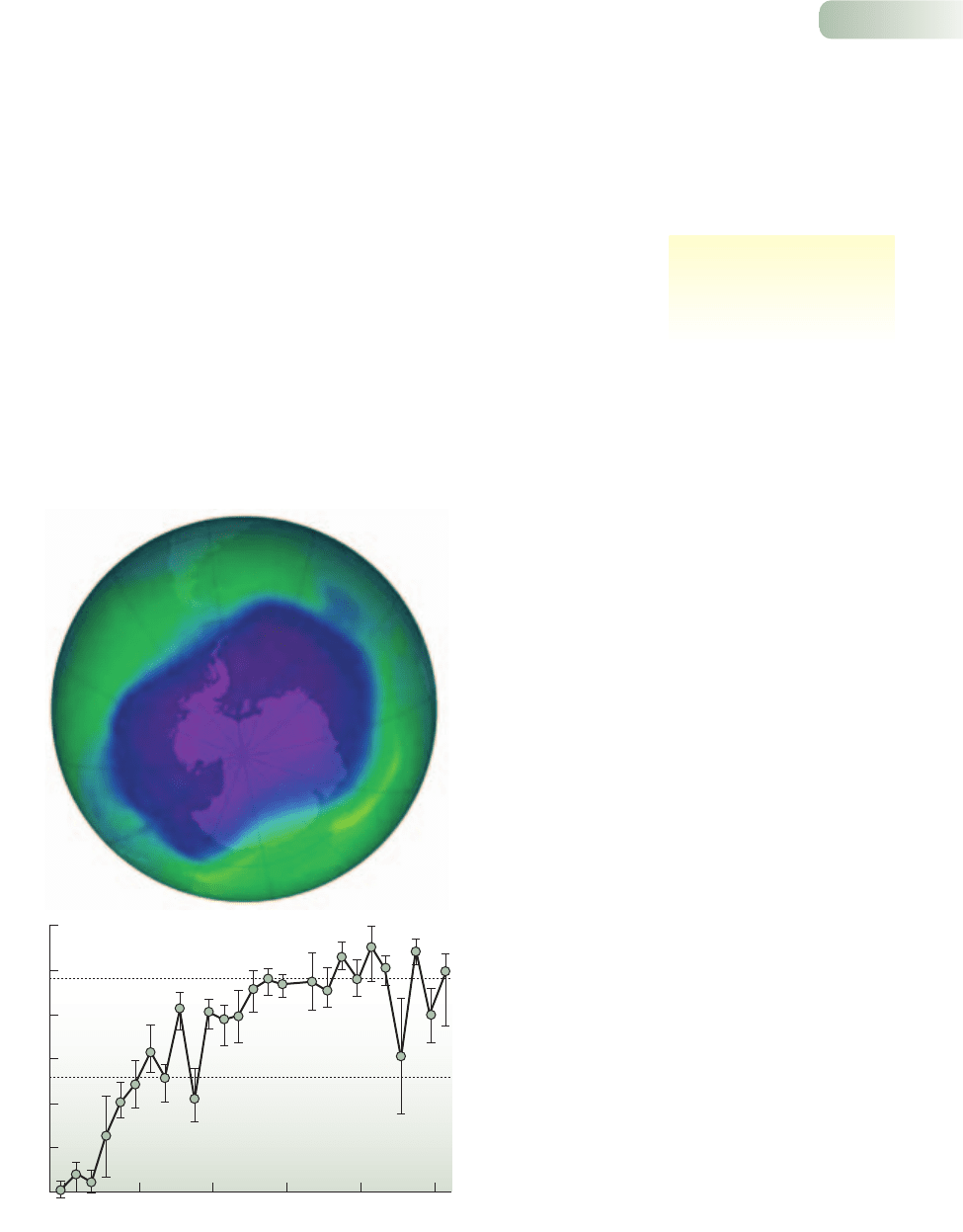Townsend C.R., Begon M., Harper J.L. Essentials of Ecology
Подождите немного. Документ загружается.


nuclear fuel can ever be made completely clean. Moreover, the polluting power
of radioactive waste has a time scale that may be orders of magnitude greater
than that of other human pollutants. For example, plutonium-239 has a half-
life of about 25,000 years. Plutonium is separated and recovered from the
spent fuel in nuclear reactors and stocks are expected to have risen to more
than 100 metric tons by 2010. Ways have to be found to protect against risks
of leakage over this sort of time scale, perhaps by burial in deep mines after
incorporation in glass.
The radiation received by an organism arises from human activities (nuclear
warfare, leakage from and accidents at nuclear plants, and medical use) together
with a very similar sized contribution from ‘background radiation’ from cosmic
rays and produced during the radioactive decay of materials such as radium and
thorium in the Earth’s crust. It is a sobering thought that the total radiation given
to a cancer patient can be many thousand times greater than the total normal
exposure from the combined natural and artificial background radiation.
A major accident in 1986 at a nuclear power station at Chernobyl in the
Ukraine released 50–185 million curies of radionucleides into the atmosphere.
Close to the explosion, 32 deaths occurred within a very short time. Farther away,
individuals contracted radiation sickness and some died. Effects in the locality
have continued to appear – livestock have been born deformed, and thousands
of radiation-induced illnesses and deaths from cancer are expected in the longer
term. Farther afield, wind-dispersed atmospheric pollution from Chernobyl was
detected in Sweden 3 days after the accident. Fallout also reached the British
Chapter 13 Habitat degradation
439
AFTER FLOWER ET AL., 1994
0
40
5
10
15
30
25
20
35
Cymbella
perpusilla
Frustulia
rhomboides
Percent
Fragilaria
virescens
Brachysira
vitrea
1988
1969
1940
1903
5.2 5.4 5.6 5.8
pH
0
10
20
30
40
Sediment depth (cm)
Sediment depth (cm)
010 01020 0 10 20 30 0 10 20 30
Date AD
6.0
Figure 13.8
The history of the diatom flora of an Irish lake (Lough Maam, County Donegal) can be traced by taking cores from the sediment at the bottom of the
lake. The percentage of various diatom species at different depths reflects the flora present at various times in the past (four species are illustrated).
The age of layers of sediment can be determined by the radioactive decay of lead-210 (and other elements). We know the pH tolerance of the
diatom species from their present distribution and this can be used to reconstruct what the pH of the lake has been in the past. Note how the
waters have acidified since about 1900. The diatoms Fragilaria virescens and Brachysira vitrea have declined markedly during this period while
the acid-tolerant Cymbella perpusilla and Frustulia rhomboides increased after 1900.
natural background radiation
and that produced by human
activities are of similar magnitude
Chernobyl – the worst nuclear
pollution disaster so far
9781405156585_4_013.qxd 11/5/07 15:03 Page 439

Isles. Figure 13.9 shows the persistence of cesium-137 in the acid soils of the
northwest of Britain, where it was absorbed by plants and eaten by sheep. The sale
of sheep for food was still banned more than 10 years after the accident because
of persistence of the isotope at dangerous levels.
13.3.3 Wind power
In this time of global climate change, harnessing the power of the wind has
much to commend it. But while this form of power generation does not release
carbon dioxide, local communities often object to the massive structures that will
appear in their localities. (This conundrum parallels the situation for hydropower
stations, which produce clean power but at the cost of altered river discharge
patterns and lost recreational opportunities downstream.) Wind farms also pose
an ecological risk in terms of threats to migrating birds. On land, soaring birds
Part IV Applied Issues in Ecology
440
2000
3000
4000
100
500
250
500
1000
250
250
500
500
1000
1000
2000
100
100
25
10
10
25
1000
100
25
10
Figure 13.9
An example of long-distance environmental pollution: the distribution
in 1988 in Great Britain of fallout of cesium-137 from the Chernobyl
nuclear accident in the Soviet Union in 1986 (measured in Becquerels
per kilogram). The contours show the persistence of the cesium on
acidic upland soils where it is recycled through soil, plants and
animals. On typical lowland soils, cesium does not persist in
food chains.
AFTER NERC, 1990
9781405156585_4_013.qxd 11/5/07 15:03 Page 440

such as falcons and vultures are at particular risk of colliding with the turbines (up
to 100 m above the ground), particularly because the engineers often select their
locations for the same wind-related reasons that birds select their routes (Barrios
& Rodriguez, 2004). Many wind farms are also planned for marine settings – in
Europe, for example, more than 100 applications have been submitted. Each may
consist of as many as 1000 turbines, up to 150 m tall, as far offshore as 100 km
and in water as deep as 40 m. The turbines may pose risks to migrating birds
(from the smallest of song birds to cranes and birds of prey) as well as sea birds
dispersing locally to find food.
Thousands of square kilometres of the marine environment off the German
coast are planned for wind farming by 2030. To predict the possible consequences
for bird populations, Garthe and Huppop (2004) developed a species sensitivity
index (SSI) for 26 seabird species, combining their scores for a range of properties,
including flight maneuverability (less agile species score highly because they are
more likely to collide with turbines), flight altitude (species flying at 50–200 m
score highly because they are more vulnerable to turbines than lower flyers), per-
centage time spent flying (those in the air for more of the time score highly) and
conservation status (‘vulnerable’ or ‘declining’ score highly). The most sensitive
species (highest SSI) include the non-maneuverable and ‘vulnerable’ black-
throated diver (Gavia arctica) and the maneuverable but ‘declining’ sandwich tern
(Sterna sandvicensis) that flies almost constantly and at perilous altitudes. The
SSI for each species was then coupled with density distribution data (low-density
species score highly because their populations are more at risk) to produce
vulnerability maps (all bird species combined) for the German area of the North
Sea. Three classes of vulnerability were assigned – ‘major concern’ (combined wind-
farm sensitive data [WSI] > 43), ‘less concern’ (WSI < 24) and ‘concern’ (between
these extremes) (Figure 13.10). Such ecological information should be taken into
account when selecting wind farm locations.
Chapter 13 Habitat degradation
441
3° 4° 5° 6° 7° 8° 9°
3° 4° 5° 6° 7° 8° 9°
55°
54°
55°
54°
Less concern
Concern
Major concern
Figure 13.10
Areas in the German sector of the North Sea (inset, right) where wind farm development is considered to be of ‘less concern’, ‘concern’ or
‘major concern’ on the basis of bird density patterns and species-specific sensitivity indexes (SSIs).
AFTER GARTHE & HUPPOP, 2004
9781405156585_4_013.qxd 11/5/07 15:03 Page 441

13.4 Degradation in urban and industrial
landscapes
A wide range of habitat degradation occurs as a result of human activity in
urban and industrial settings. Marked changes to riverflow result from the loss
of permeable surfaces – roofs, pavements and roads are impermeable, in contrast
to field and forest. Our feces, urine and dead bodies create large disposal problems
in towns and cities because density is so high. Exotic industrial chemicals find their
way into waterways and the atmosphere. And our mining activities, whether for
fossil fuels or valuable jewels or ores, cause physical and chemical degradation to
surrounding ecosystems. In this section, our examples encompass sewage disposal
(Section 13.4.1), the industrial production of fluorocarbons and consequences
for the ozone layer (Section 13.4.2) and the ecological problems associated with
mining (Section 13.4.3).
13.4.1 Disposal of bodily waste
All human body products, but most notably feces and urine, can be regarded
as pollutants. The Greeks were probably the first to control the accumulation
of pollution within towns, and a law of 320
BC forbade dumping of waste in
the streets. The Romans were also very pollution conscious, dumping city waste
in pits outside the city walls. When Roman and Greek civilizations perished,
their quite sophisticated control of urban pollution collapsed. Medieval castles,
for example, were often designed with latrines projecting from castle walls that
simply dumped waste at the base of the walls (the accumulated wastes give
archeologists a direct record of historical diets and infestation with intestinal
worms!). Until the 14th and 15th centuries the open streets again became the
main, and often the only, destination for human and animal feces and urine.
A special trade developed, that of the scavenger, who was paid to carry waste to
dumps outside the cities; in 1714 every city in England had an official scavenger
(the forerunner of the Environmental Protection Agency!). Even when water
closets (invented by Thomas Crapper) began to be installed in some countries
early in the 19th century, the underground reservoirs (cesspools) into which
they emptied often overflowed and contaminated drinking water. Outbreaks of
cholera in the middle of the 19th century were traced directly to this source of
contamination, a discovery that led to the connection of household waste directly
to sewers in both Britain and the United States.
At first glance, the easiest way to cope with accumulated feces and urine might
appear to be to dilute them in large bodies of water. However, it is not easy to
dispose of human waste and at the same time provide healthy drinking water. In
addition to health issues, we have already seen in Section 13.2.2 how there can
be profound ecological effects of disposing of sewage in water bodies.
All natural ecosystems have an inherent capacity to decompose feces and
up to a point natural decomposition processes in rivers, lakes and oceans may
cope with increased organic matter from human sewage without obvious changes
to the nature of the biological communities they contain. However, problems
arise when the rate of sewage input exceeds this capacity. First, excessively high
rates of decomposition of dead organic matter in rivers and lakes can lead to
Part IV Applied Issues in Ecology
442
when natural ecosystems cannot
cope with human waste...
9781405156585_4_013.qxd 11/5/07 15:03 Page 442

anaerobic conditions (causing the death of fish and invertebrates). This happens
because oxygen is consumed by the decomposer microorganisms faster than it
is replenished from photosynthesis by aquatic plants and diffusion from the air.
Second, the supply of nutrients such as phosphate and nitrate that normally limit
plant growth in water bodies may be increased to a level where algal growth is
so great that it shades and kills other aquatic plants – the cultural eutrophication
discussed in Section 13.2.2.
Modern sewage systems were developed as ecological devices for pollution
management. They aim to capture pollutants from waste water and to clean it,
usually in a drainage system separate from the one that carries heavy flows of
storm water. Ideally, a sewage system cleans polluted water to a state suitable
for drinking before discharging it back into rivers, lakes and the sea. The full
treatment of sewage has three stages (Figure 13.11), though in many places
only the first or first and second stages are actually used before discharge into
the environment.
After paper, rags and plastic have been removed by passing the sewage through
screens, primary treatment is a physical process in which much of the solid
Chapter 13 Habitat degradation
443
Business
Industry
Bar screen
Secondary treatment
Rivers, lakes, and sea
Sludge
Biosolids
Sludge
Digester
Chlorine
Ultraviolet light irradiation
Dewatering
Removal of paper,
rags and plastics
Homes
Primary settling tank
Secondary
sedimentation tank
Tertiary nutrient stripping
Pumping
station
Biosolids
land application
Solid
storage basin
Dedicated
land disposal
Waste water Waste water
Figure 13.11
The sequence of treatments
commonly applied to the sewage
waste from a modern urban
community.
. . . sewage treatment systems
are needed
9781405156585_4_013.qxd 11/5/07 15:03 Page 443

organic sewage waste is allowed to settle to the bottom of settlement tanks, from
which it is removed as sludge.
Secondary treatment is an engineered biological process designed to mimic (and
indeed enhance) natural decomposition. In its simplest version, the partly cleaned
water is sprayed onto a layer of crushed rock within which microorganisms have
been encouraged to grow; as the water trickles down through these percolating
or trickling filters, natural decomposition mineralizes much of the remaining
organic matter, releasing carbon dioxide to the atmosphere. A more sophisticated
and efficient method of secondary treatment is the activated sludge method, in
which the sewage is passed into aerated tanks containing sludge that is activated,
or seeded, with microorganisms. After secondary treatment the remaining solids
are settled to yield more sludge. The waste water now appears clean, but it still
contains two types of impurity, namely disease organisms and high concentrations
of mineral nutrients, the latter having both health consequences (Section 13.2.2)
and causing eutrophication if released into rivers and lakes.
A final ‘polishing’ stage usually includes chlorination, and sometimes ultra-
violet (UV) light irradiation to kill bacteria. Full tertiary treatment involves the
stripping of nutrients, largely by artificial and expensive chemical processes.
Untreated sewage is obviously a pollutant, with adverse health and ecological
consequences for water bodies into which it is discharged. However, discharge of
sewage that has only been subject to primary treatment is still likely to cause eutro-
phication because it remains rich in organic matter and nutrients. Moreover, even
secondary treatment removes only the organic matter, leaving waste water rich in
plant nutrients. The sludge that accumulates in settling tanks is itself a pollutant
that has to be disposed of, usually by dumping at sea or burying in landfill sites.
Buried sludge decomposes anaerobically, sometimes taking more than 20 years to
mineralize completely, and it produces methane, which is a greenhouse gas that
contributes to global climate change (Section 13.3.1). Sludge can be more appro-
priately used as a fertilizer, either dried or as a liquid sprayed onto the land; in this
way the nutrient cycle can be reconstituted by returning nutrients, assimilated
from crops by people, to agricultural land to be taken up by future crops.
13.4.2 Chlorofluorocarbon compounds and thinning of
the ozone layer
Ozone is produced by the influence of sunlight on oxygen and during the oxida-
tion of carbon monoxide and hydrocarbons such as methane. It has three very
different roles in environmental pollution. The first two are negative, in the sense
that undesirable polluting consequences occur as the concentration of ozone
increases. First, in atmospheres polluted with methane, industrial hydrocarbons,
oxides of nitrogen and carbon monoxide, ozone can reach concentrations that are
toxic to plants and that contribute to smog. Second, ozone is also a greenhouse
gas, though it is not particularly significant in this respect.
However, ozone also accumulates as a layer in the upper atmosphere. This
‘ozone layer’ is beneficial because it absorbs most of the UV radiation (wavelength
200–300 nm) incident on the Earth’s upper atmosphere and so makes the Earth
habitable for plants and animals. The increasing frequency of skin cancer among
humans has focused attention on the damage caused by exposure to the sun and
on the importance of stability of the ozone layer.
Part IV Applied Issues in Ecology
444
products of sewage treatment
are themselves pollutants
ozone can have adverse
consequences locally...
. . . but in the upper atmosphere
it shields the Earth from
damaging UV radiation
9781405156585_4_013.qxd 11/5/07 15:03 Page 444

Evidence that nitric oxide produced by supersonic aircraft might contribute
massively to reduce the level of atmospheric ozone led to the halting of their
large-scale development. However, that has by no means been the end of the
story. Chlorofluorocarbon compounds (CFCs) had been developed as aerosols
and refrigerants and used on a very large, international scale. It became clear that
these posed the threat that their chlorine content could interact with and destroy
atmospheric ozone.
Ozone chemical processes are very complicated, and methane, nitrous oxide
and carbon monoxide may all play a part in its decomposition. The upper atmo-
sphere is not the easiest place in which to study the chemical characteristics of
gases! But pollution of the upper atmosphere poses questions of the greatest
significance for environmental scientists, especially since the discovery that the
concentration of ozone in the atmosphere over Antarctica had started to decline by
1978 and was doing so very rapidly after 1982. The phenomenon happens at the
start of the southern hemisphere spring (August to October). The size of the ozone
hole over Antarctica on September 24, 2006 was one of the largest ever recorded,
equivalent to more than the surface area of North America (Figure 13.12). It is
Chapter 13 Habitat degradation
445
(a)
(b)
Area of North America
Area of Antarctica
Size of ozone hole (million km
2
)
30
25
20
15
10
5
0
1980 1985 1990 1995 2000 2005
Year
chlorine compounds and other
pollutants decompose ozone
in the atmosphere and need
to be phased out
Figure 13.12
(a) An image of the ozone hole over Antarctica for September 24,
2006; the blue and purple colors are where there is least ozone
(<220 Dobson units). (b) Average size of the ozone hole from
September 7 to October 13 each year from 1980 to 2006. The
vertical lines show the minimum and maximum areas during this
period each year.
COURTESY OF THE US NATIONAL AERONAUTICS AND SPACE ADMINISTRATION, WWW.NASA.GOV
9781405156585_4_013.qxd 11/5/07 15:03 Page 445

clearly in the interests of humans and probably most other organisms that ozone
concentrations should remain low close to the Earth’s surface (e.g. minimizing
smog) but high in the upper atmosphere, and that we should find out how to
ensure this. International agreements to phase out CFCs are expected to lead to
recovery of the ozone hole by about 2050.
13.4.3 Mining
Our dependence on fossil fuels has effects that go beyond atmospheric pollution.
The extraction and transport of coal and especially oil can also cause physical
disruption of habitats. Thus, more than 1 million tonnes of oil enters the world’s
waterways every year from wells drilled into the seabed or from oil tankers. Oil
in and on the sea affects wildlife in many ways. It reduces the level of aeration
of the water, and it prevents light from penetrating the surface. Damage to
invertebrates can be widespread, affecting chitons, mussels, crustaceans and
bryozoans, as well as seaweeds and kelps. Feathers become choked with oil so
that sea birds cannot fly and fish gills become coated and cease to function.
The largest accident in the United States occurred on March 24, 1989, when
the oil tanker Exxon Valdez ran aground in Prince William Sound, Alaska. It
spilled nearly 50,000 tons of crude oil, which spread along the coast for nearly
1000 km, contaminating the shores of a national forest, five state parks, four
state critical habitat areas and a state game sanctuary. The episode is believed
to have killed 300 harbor seals, 2800 sea otters, 250,000 birds and possibly
13 killer whales. Many commercial fisheries were closed for a year or more
because of the concern that fish caught in the area might find their way into the
human food chain. By 1996, 28 species and resources were still listed as having
failed to recover.
Metals were first used by humans in the late Stone Age, about 6500 years
ago. Gold, silver and copper were the first metals used; they are easy to extract
because they exist in nature as the metals themselves rather than as chemical com-
pounds. Nuggets of pure metallic gold were found in riverbeds and were beaten
and molded for decoration. Once such metals were valued it was an obvious step
to dig and mine for them, and from that point almost every phase in the extrac-
tion and industrial use of metals involves a sequence of phases of environmental
pollution.
Each type of metal has its own peculiarities. Here we use the mining and
purification of copper to illustrate pollution through the extraction of metal.
Copper is present in deposits either as the metal or as copper sulfide or oxide.
Like most metal deposits, it usually exists in a mixture with other metals, some
of which may be worth saving (e.g. gold), whereas others are discarded in more
or less hazardous waste.
The mining industry may pollute at every stage of extraction, purification and
disposal:
1 Mining and quarrying. Mining or quarrying exposes the metal and its ores.
Many of the world’s copper reserves are close to the surface and are easily
extracted by open cast mining: the copper mines of Bougainville (Solomon
Islands, Papua New Guinea) and of Utah are among the largest human scars
on the Earth’s surface (Figure 13.13).
Part IV Applied Issues in Ecology
446
physical disruption from the
mining of fossil fuels
the mining and purification
of copper
9781405156585_4_013.qxd 11/5/07 15:03 Page 446

2 Processing. The ores are crushed and finely ground. This processing
immediately exposes ores to the elements, and even after the best has been
extracted the residues are copper-rich and the metal leaches as toxic waste
into rivers and lakes. Waters close to copper mines are commonly brilliantly
blue-green with copper salts and quite sterile.
3 Concentration. The finely ground ore is agitated in water, and the metal
becomes concentrated in the froth and dried to a cake. The remainder,
which is still rich in copper, may be further concentrated to recover more of
the metal. Ultimately water and solid ‘tailings’ have insufficient copper to
warrant further extraction but contain sufficient copper to form a hazardous
and polluting waste.
4 Purification through heat. The concentrate is then roasted to 1230–1300°C,
polluting the atmosphere by the burning of the necessary fuel. The roasting
drives off a host of pollutants such as arsenic, mercury and sulfur into the
atmosphere.
5 Purification through electrolysis. The copper can now be purified by
electrolysis, which leaves most of the other metals in a sludge that may be
further purified (to remove gold, for example) but ultimately contributes
yet more toxic waste.
The major role of some metals as environmental pollutants occurs after they have
been purified and used industrially and are then released into the environment as
industrial waste. Lead and mercury are particularly striking examples. Lead became
an environmental pollutant from the moment that the Romans started to use it
to make water pipes and so started to pollute their drinking water. It is ranked by
the US Environmental Protection Agency as number 1 in their list of 275 hazardous
substances, posing a particular risk for the development of the nervous system in
young children and in the fetus. It is being phased out of many commercial uses.
Chapter 13 Habitat degradation
447
Figure 13.13
Binyon Canyon Mine, Utah. A toxic and sterile
environment created by the world’s largest
excavation.
© DAVID R. FRAZIER
lead and mercury can be
especially dangerous pollutants
9781405156585_4_013.qxd 11/5/07 15:03 Page 447

It is not clear whether lead pollution has significant consequences for wildlife on
the land or in aquatic environments, but it does not appear to become concentrated
along food chains. This is a major contrast with mercury.
Mercury is used in a variety of specialized applications in industry and
medicine – in electric switches, batteries, fluorescent and mercury vapor lights,
thermometers, barometers and dental amalgams. The main culprits in releasing
mercury to the atmosphere are, in order of importance, coal-fired power plants,
medical waste incinerators, municipal waste incinerators and industrial boilers.
In the natural environment mercury can be converted by microbial activity to
methylmercury, a form that is readily absorbed and accumulated up food chains,
especially in lakes and estuaries. Fish, the top predators, may accumulate con-
centrations of mercury 10,000 to 100,000 times that in the surrounding water
(Bowles et al., 2001). Native peoples who hunt and eat wildlife can accumulate
even higher concentrations. Mercury is a serious poison that can cause permanent
damage to the human brain and kidneys, and particularly to the developing fetus.
It may also damage the immune system.
Land that has been damaged by mining is usually unstable, liable to erosion
and devoid of vegetation. The simplest solution to land reclamation is the
re-establishment of vegetation cover, because this will stabilize the surface, be
visually attractive and self-sustaining (Bradshaw, 2002). Candidate plants for
reclamation are those that are tolerant of the toxic heavy metals present. Of
particular value are ecotypes – different genotypes, within a species, that fill
different niches (see Section 2.3.1) – that have evolved resistance in mined areas.
Thus, certain metal-tolerant grass genotypes (or cultivars) have been selected
for commercial production in the UK for use on neutral to alkaline soils con-
taminated by acidic copper wastes (Agrostis capillaris cultivar ‘Parys’) or lead or
zinc (Festuca rubra cultivar ‘Merlin’) (Baker, 2002).
In addition, many species characteristic of naturally metal-rich soils have
evolved biochemical systems for nutrient acquisition, detoxification and the
control of local geochemical conditions. Phytoremediation of metal-contaminated
sites can take a variety of forms (Susarla et al., 2002). Phytoaccumulation occurs
when the contaminant is taken up by the plants but is not degraded rapidly or
completely; these plants, such as the zinc-accumulating herb Thlaspi caerulescens,
are harvested to remove the contaminant and then replaced. Phytostabilization,
on the other hand, takes advantage of the ability of root exudates to precipitate
heavy metals and render them biologically harmless. Finally, phytotransformation
involves elimination of a contaminant by the action of plant enzymes; for example,
hybrid poplar trees Populus deltoides × nigra have the remarkable ability to
degrade TNT (trinitrotoluene) and show promise for the restoration of munition
dump areas.
13.5 Maintenance and restoration of
ecosystem services
We have now considered a range of examples of the many impacts of human
activities on ecosystems, noting that these can often be measured in terms of lost
‘ecosystem services’ (Section 13.1.2). The concept of ecosystem services brings
Part IV Applied Issues in Ecology
448
prospecting for plant species to
restore contaminated sites
a triple bottom-line approach to
natural resource management
9781405156585_4_013.qxd 11/5/07 15:03 Page 448
